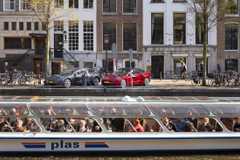Affairs: The future of the car / Global
Is the future electric?
We all know the promise: a green driving future thanks to electric vehicles. But there are some bumps in the road and, beyond compact, wealthy cities, is the world really ready? We hit the road to find out.
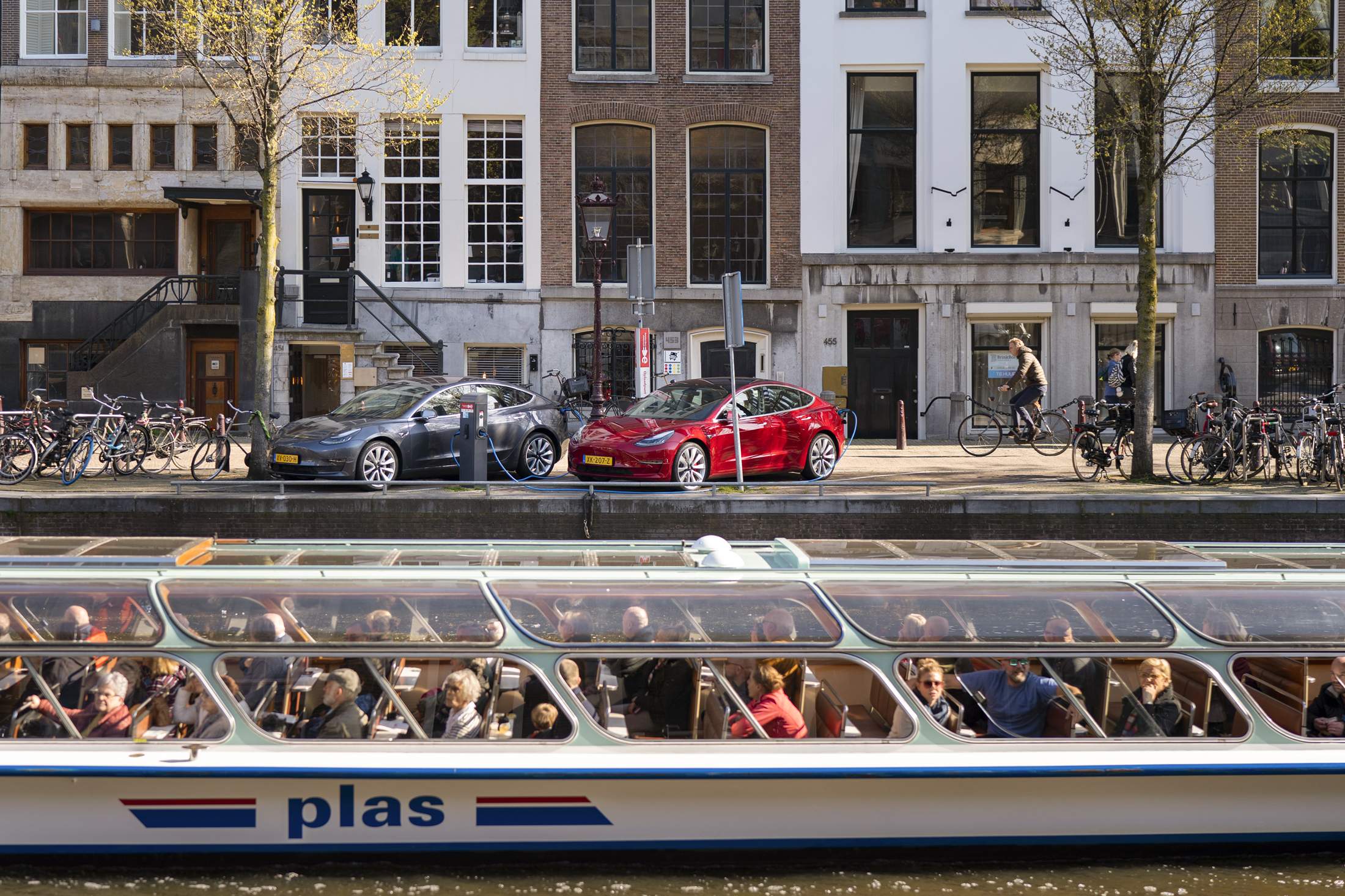
The internal combustion engine (ice) is one of humanity’s most significant inventions. Its use in the automobile has become the benchmark of personal mobility – but that is undergoing a gear shift. Road transport accounts for 16 per cent of global carbon emissions and world leaders have the traditional car in their crosshairs. The US, EU and UK have pledged to ban the sale of ice vehicles over the next two decades. So, if humanity is to innovate its way out of the climate crisis, it needs to reinvent four-wheeled travel.
The electric vehicle (EV) seems to have done just that. Sales of EVs have grown from 120,000 worldwide in the whole of 2012 to more than that every week in 2023. Yet this growth has stalled of late. Some of the reasons are technological, including discrepancies between manufacturers’ claims about battery life and the actual mileage. Then there’s the infrastructure. Even in EV-enthusiastic countries, charging points are relatively scarce, operated by myriad providers with frustrating idiosyncrasies in charging time and payment. And there’s price: exacerbated by recent inflation and supply-chain problems, most EVs are prohibitively expensive for the average consumer (brand new, the cheapest start at about €23,500). Finally, the fundamental issue: the environmental benefits. Though they produce zero emissions when driven, EVs are reliant on rare-earth minerals often mined in developing countries or from the ocean floor – both carbon-intensive and damaging.
The automotive industry must find a way to navigate these bumps in the road if governments are to mitigate the worst effects of climate change. Adoption of greener forms of transportation is essential in this regard. But the idea that the world is heading inexorably towards mass EV use might not be so straightforward. If people, especially those living in developing countries, are to be persuaded along for the ride, both the technology and infrastructure need to improve. Otherwise it will be a shift that only accelerates in wealthy cities in developed nations. Advocates might argue that it’s not about the journey but the destination – yet we won’t reach the latter unless drivers are convinced that the former is worth it.
The Amsterdam experiment
Charging ahead but a deadline looms
It’s hard to imagine Amsterdam, with its road-and-canal network that was originally designed for horses and boats, as a pioneer of urban mobility. Yet a vehicular revolution is taking place in this 750-year-old city. In one of Europe’s most ambitious plans, Amsterdam aims to be free of all carbon-emitting vehicles by 2030.
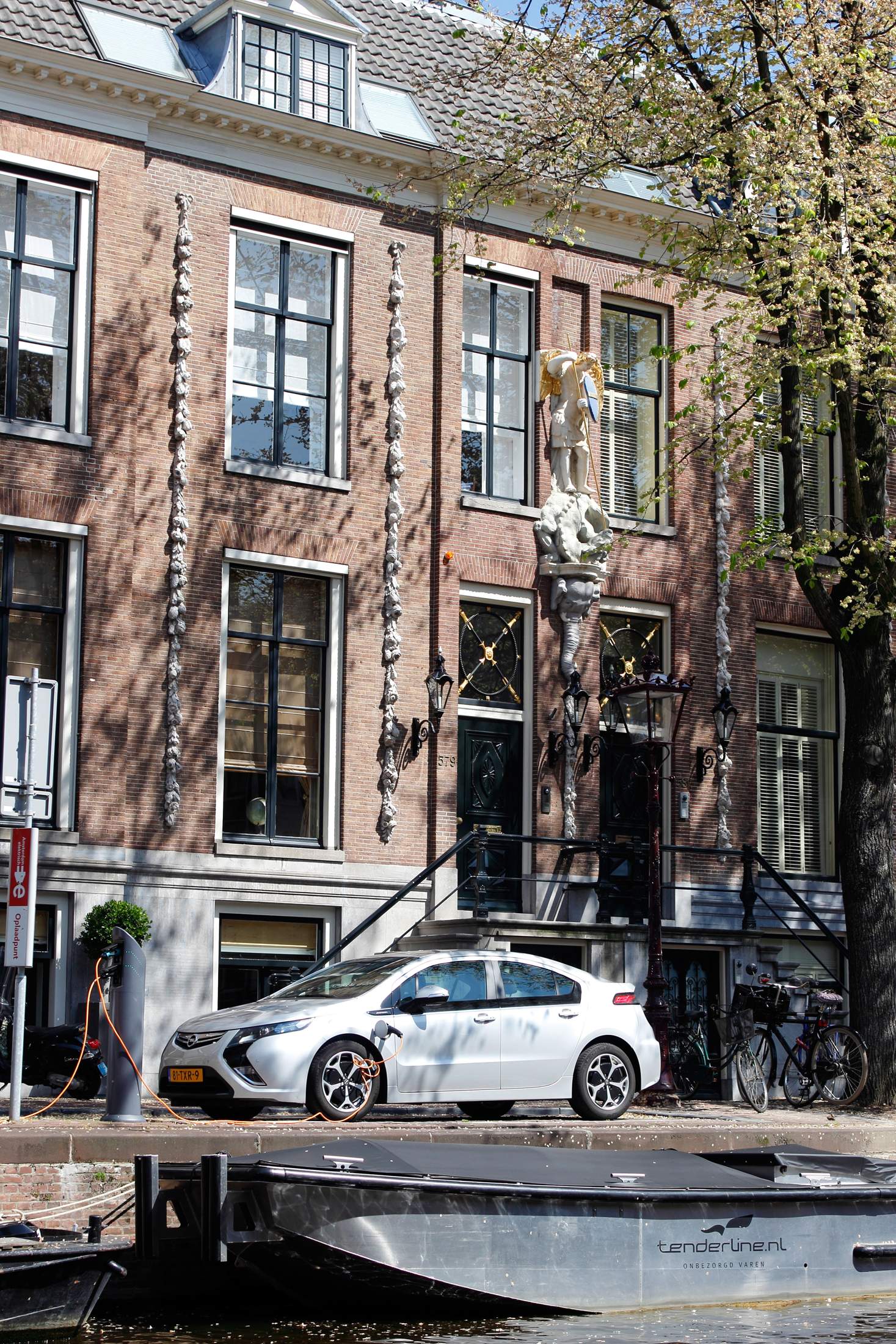
On the charge

Birò’s Pieter Vermeer
The Dutch capital has more than 6,000 public EV recharging points, making it one of Europe’s top-three cities for charging infrastructure, alongside Oslo and London. Under Amsterdam’s plan, there will be 18,000 points by 2030, as well as tens of thousands more semi-public and private points, all powered by renewable sources.
Amsterdam was an early adopter of EVs, launching its first policy to tackle air pollution in 2009. “Today public charging is a no-brainer for cities but in 2009 there was just a handful of electric cars,” says Tom Groot, a sustainable-mobility adviser to the city’s government. “Amsterdam started to break the chicken-egg dilemma.” In 2020 the city’s updated Clean Air Action Plan came into force, banning some diesel cars from the centre. The next step, in 2025, bans all carbon-emitting taxis, delivery vehicles, public buses and coaches, followed by a complete ban on all carbon-emitting vehicles across the city in 2030. But Amsterdam faces logistical, social and economic challenges, especially when it comes to convincing its motorists to make the switch to electric when the technology is far from perfect and the costs are prohibitive for many.
Groot is keen to stress that the policy isn’t aimed at getting everyone to switch to EVs but at moving the city towards a car-free future and encouraging greater use of public transport, bicycles and vehicle-sharing solutions. In 2022, three years after Amsterdam launched its clean-air policy, 6 per cent of all passenger cars in the city were all-electric – a figure higher than the national average. The city doesn’t track that figure on a yearly basis but sales of new EVs are continuing to soar; about 25 per cent of all new cars sold in the Netherlands last year were electric and city hall says that the figure is probably higher in Amsterdam.
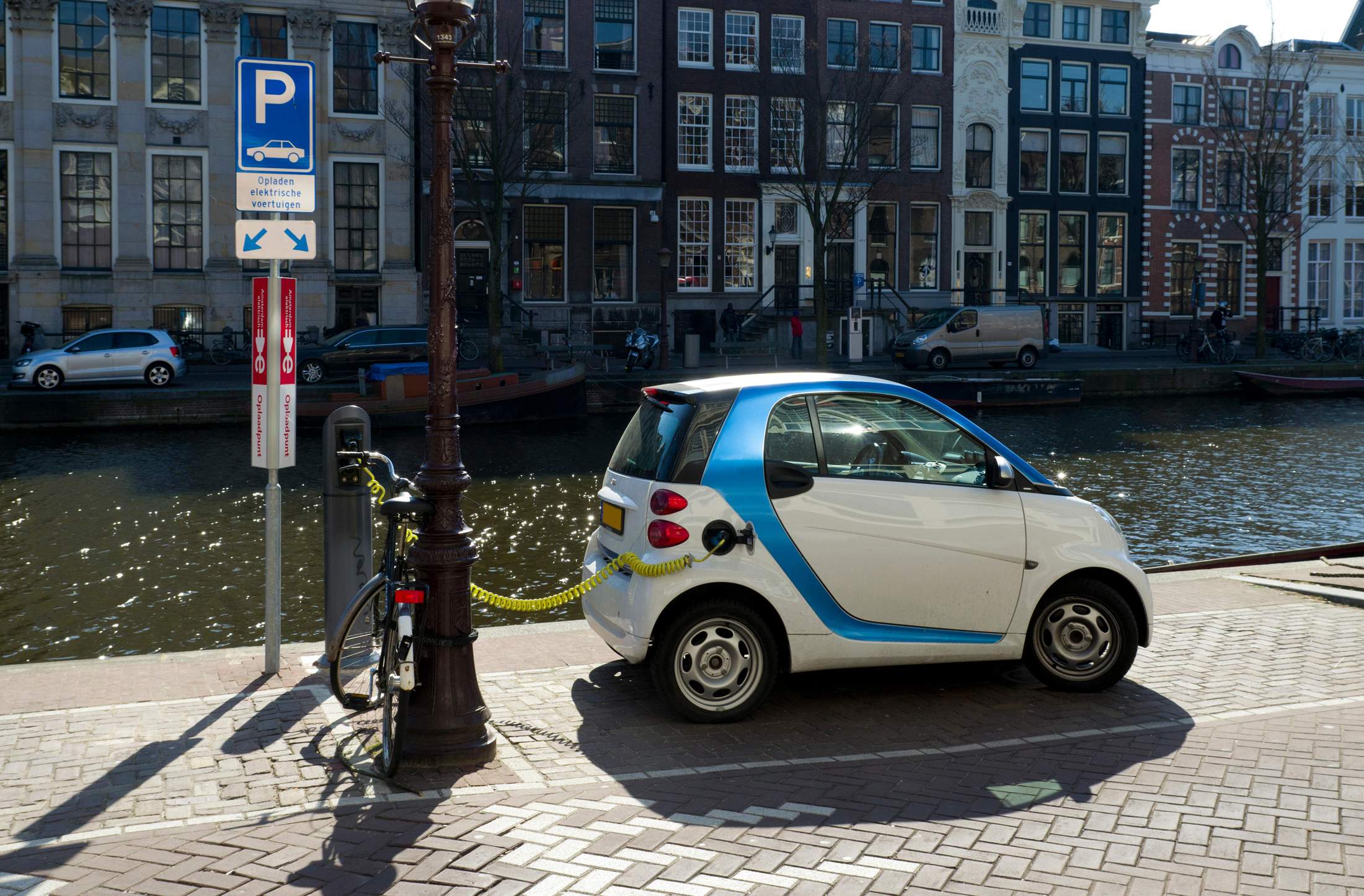
Current thinking

Saïd Bentarcha
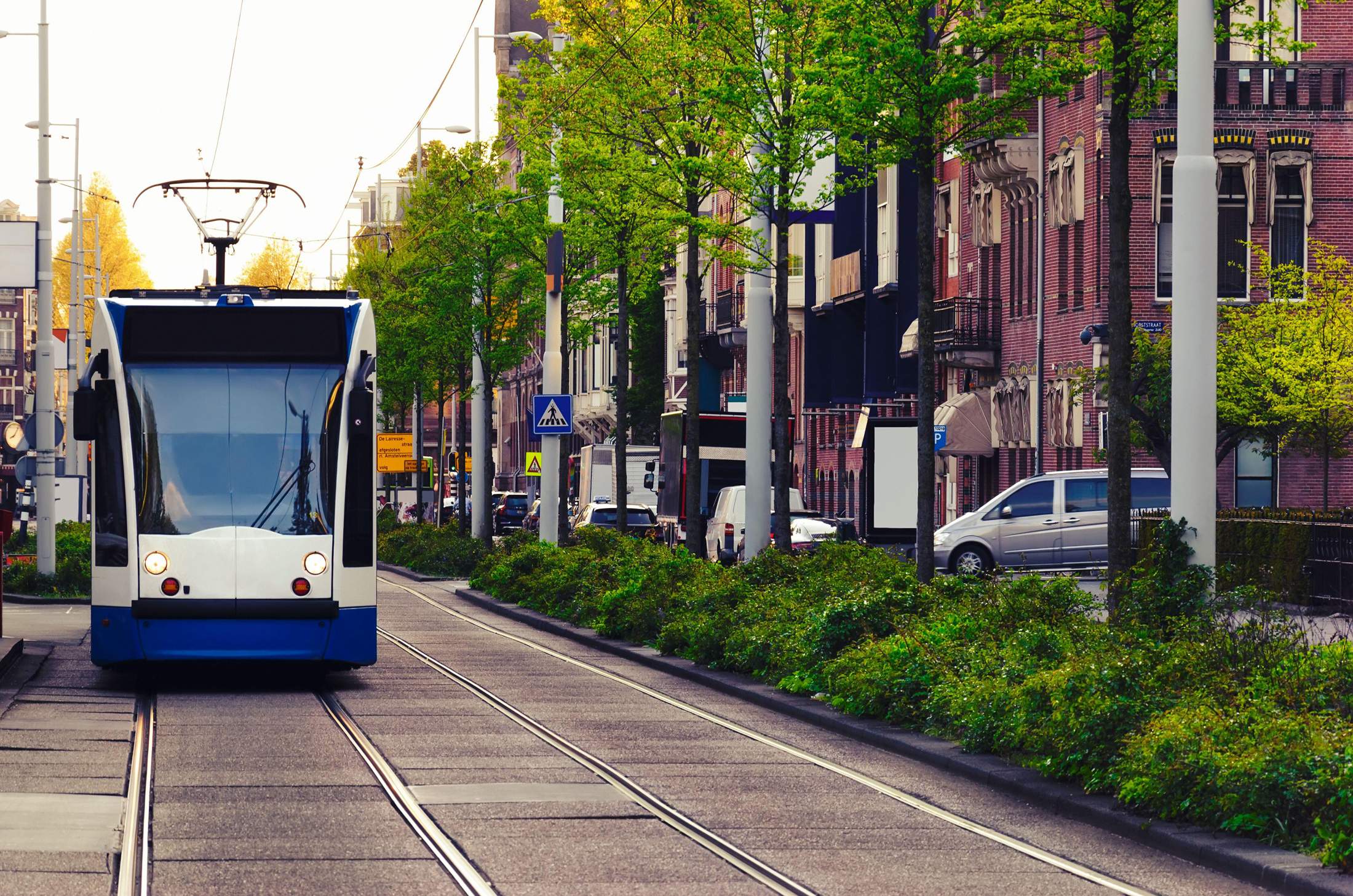
Electric avenue
The Dutch government also offers tax incentives and subsidies of as much as €2,950 for buying or leasing EVs. However, these incentives ebb and flow. Last year national subsidies had run out by May. And while Amsterdam once offered free parking permits to EV owners, that policy was phased out as growing demand made it unsustainable. Today, EV owners get priority on the parking-permit waiting list. If an EV owner doesn’t have a private parking space, the city will install a public charging point near their home.
Amsterdam’s aggressive approach could become a template for other cities but Groot concedes that huge challenges remain in reaching the 2030 target. “We are dependent on external factors,” he says. “For example, when will there be an affordable electric car for the masses and an affordable secondhand market?”
At Alphabet Occasions, a secondhand car dealership, sales officer Gert Kool says that just 3 per cent of the cars he sold last year were electric. There are practical and financial reasons why people are reluctant to make the switch. Amsterdam’s plan comes at a difficult time, with the high cost of living and the war in Ukraine sending energy prices soaring. And while the Netherlands – home to the highest number of charging points in Europe, flat landscapes and short distances between urban centres – is well suited to EVs, anyone who wants to drive outside the country faces challenges. “For many people, it’s not functional,” says Kool. “The cars usually have a range of about 180km or 200km. And at the moment electricity is expensive.” However, he estimates that by 2030, half of the vehicles in his showroom will be electric, as the EV-lease cars now on the roads find their way to the secondhand market.
But that doesn’t help people like Dennis, a self-employed Uber driver. Since carbon-emitting taxis will be banned from the city centre in less than two years, he decided to go electric now. But when he applied for a subsidy, he was told that the pot was empty. “Nobody is happy about it because it’s a big investment,” says Dennis, who declined to supply his surname. Yet, for every reluctant adopter, there are enthusiastic cheerleaders for EVs. Entrepreneur Saïd Bentarcha bought the Amsterdam-based company Travel Electric in 2021. It began life as Taxi Electric in 2011, one of the world’s first fully electric taxi firms. For all its green credentials, however, it was a case study in what can happen when ambition isn’t matched by infrastructure and technology. “When it started, there were few cars available and only one model, the Nissan Leaf, which had a range of 120km,” says Bentarcha. “Drivers had to switch cars during their shift. That took a lot of time – and a lot of time costs a lot of money.” The company has gone bankrupt twice but today it has a growing roster of corporate clients hiring its immaculately suited drivers to meet sustainability goals.
Amsterdam’s ambition for an emission-free future should be applauded and the carrot-and-stick approach of incentives and enforced deadlines appears to be pushing businesses and taxi drivers to make the switch ahead of the next deadline in 2025. But, to clear the final hurdle and get all carbon-emitting cars off the roads by 2030, Amsterdam is betting on factors that are beyond its control, including innovation in the car industry and a resolution to global energy issues. Elise Moeskops, an Amsterdam city council member with the d66 party who works on transport policy, insists that the target can be met. “Setting a clear date drives innovation,” she says. “Though 2030 is already too late, that’s the soonest year that is feasible. We know that we’re pushing it but we need to push.”
Small wonders
Entrepreneur Pieter Vermeer began importing the Birò electric micro-car from Italy to the Netherlands in 2013. Initially classed as disability vehicles and allowed to drive on bike paths and park on the pavement, they soon provoked a public backlash. In 2019 they were re-classed as cars. Given their small size, three or four Birò vehicles could fit in one parking spot; Vermeer envisages a similar scheme to e-bike and e-scooter sharing models, with the added benefit of shelter from the weather. He is also in talks with the city about a pilot programme in which Birò owners can rent out their vehicles via an app.
Revolution, parked
Why are modern cars so ugly?
“I try to design a car so that every time you get in it, you have a little vacation,” said General Motors designer Harley Earl in the 1940s and 1950s (writes Andrew Nahum). To his critics, Earl’s reign spelt irresponsibility, mining the US’s burgeoning aerospace programme for jet-plane motifs. But he also created the industry’s studio system, which iterated (and reiterated) the car’s changing form at a time when it jostled for primacy with its function.
Today’s design processes are arguably more meticulous, though powerful software supplements the use of pencils, paper and clay. Drawing and modelling are still crucial and many designers will have compulsively sketched cars since childhood – but what about that little vacation that Harley Earl promised?
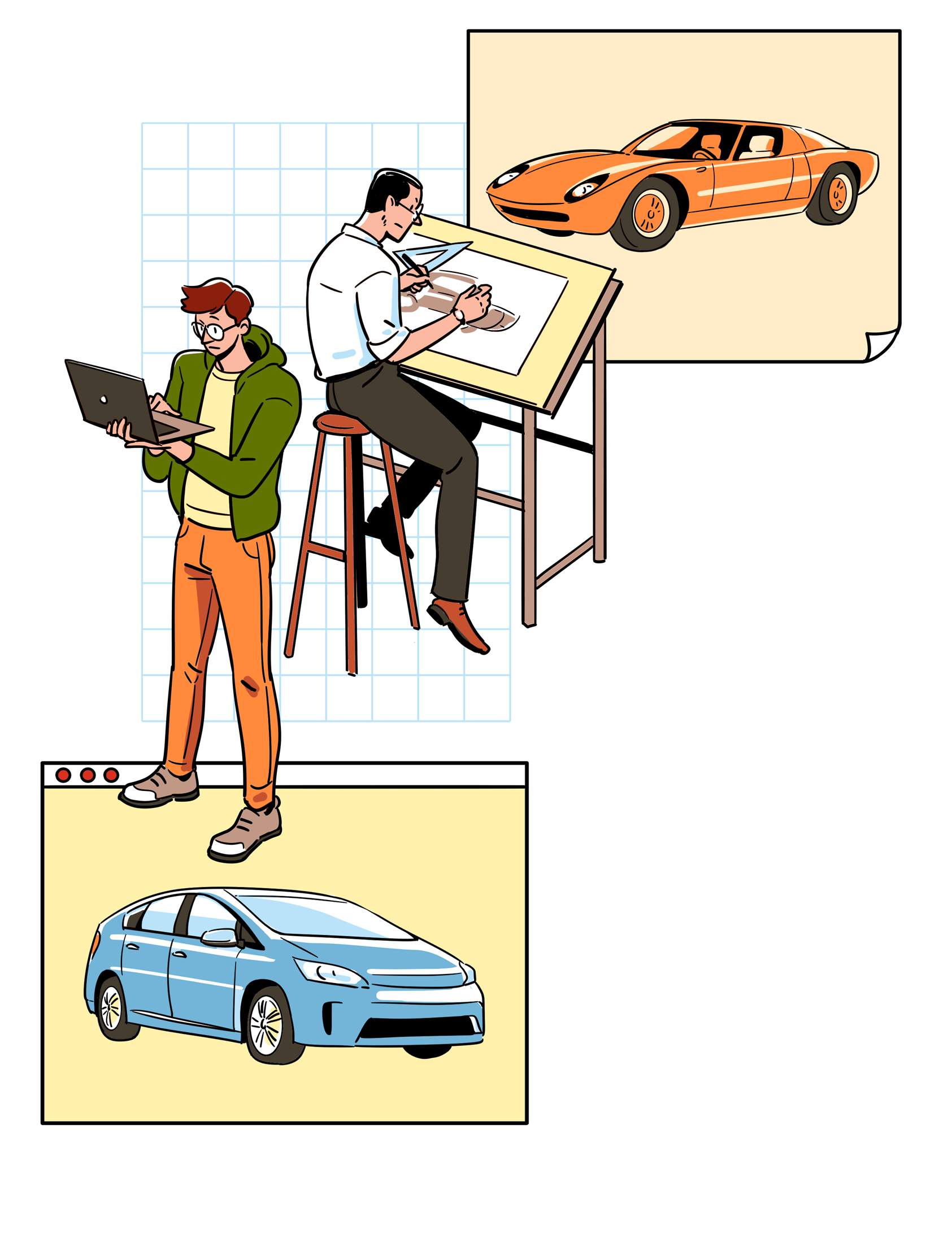
In the 21st century, few motorists will find the car to be as joyful. Why is the current generation of automobiles so dull-looking? National identity in car design – back when Fiats, Renaults and Volkswagens all spoke to their home country’s aesthetics – is long gone. But now it seems as though the whole industry has lost its touch. Except for supercars and tractors, automobile design has become depressingly routine. Functionalism must be there but what about elegance, originality and wit?
The move to electric cars is one reason why designers might have lost touch with these emotions. A few years ago, they looked forward to liberation – freed from archaic mechanical parts, electric cars would find new revolutionary shapes. That didn’t happen. Lithium batteries are sensitive and can’t simply be distributed around the vehicle, provoking new curves and emotions, because of the danger of potential impact. A lithium-battery fire is almost impossible to extinguish, so the battery pack is protected as much as the occupants.
Crash-design geometry must still be there, even if there is no engine, so a Tesla has an empty bonnet (a “frunk”) providing “ride-down” distance, which deforms progressively to save occupants from the worst of the deceleration. If you have a set of fitted luggage in your frunk (bmw has recently teamed up with Louis Vuitton), that might even help.
The electric pack is also big and heavy – like four people aboard before you even get in – so it’s installed low, to avoid sway and lurch, and the battery becomes an underfloor layer. These constraints make the mid-size car high and boxy. New petrol models emulate this aesthetic too. Designers might even have lost their mojo in a culture where car ownership is being painted as something selfish.
Periods of stasis and revolution characterise most design – and most great art – until a true disruptor emerges to change what we expect. In car design, there was the incomparable Ettore Bugatti, Alec Issigonis and his Mini, Spen King with the Range Rover and Giorgetto Giugiaro with the Volkswagen Golf. Will there be another car paradigm shift, or are we trapped by technological insistence? Could we see the automotive equivalent of a Duchamp or Dalí, or will globalisation and environmentalism mandate homogenisation?
Maybe it’s time to update the old featherlight Citroën 2cv. Removing the bulk and enormous weight of a contemporary suv would save a ton of metal and halve the energy required to push it along. Do we really need a self-opening motorised tailgate before we head to the gym?
Andrew Nahum is a curator and writer. His books include ‘Ferrari: Under the Skin’ and ‘Paths of Fire: The Gun and the World It Made’.
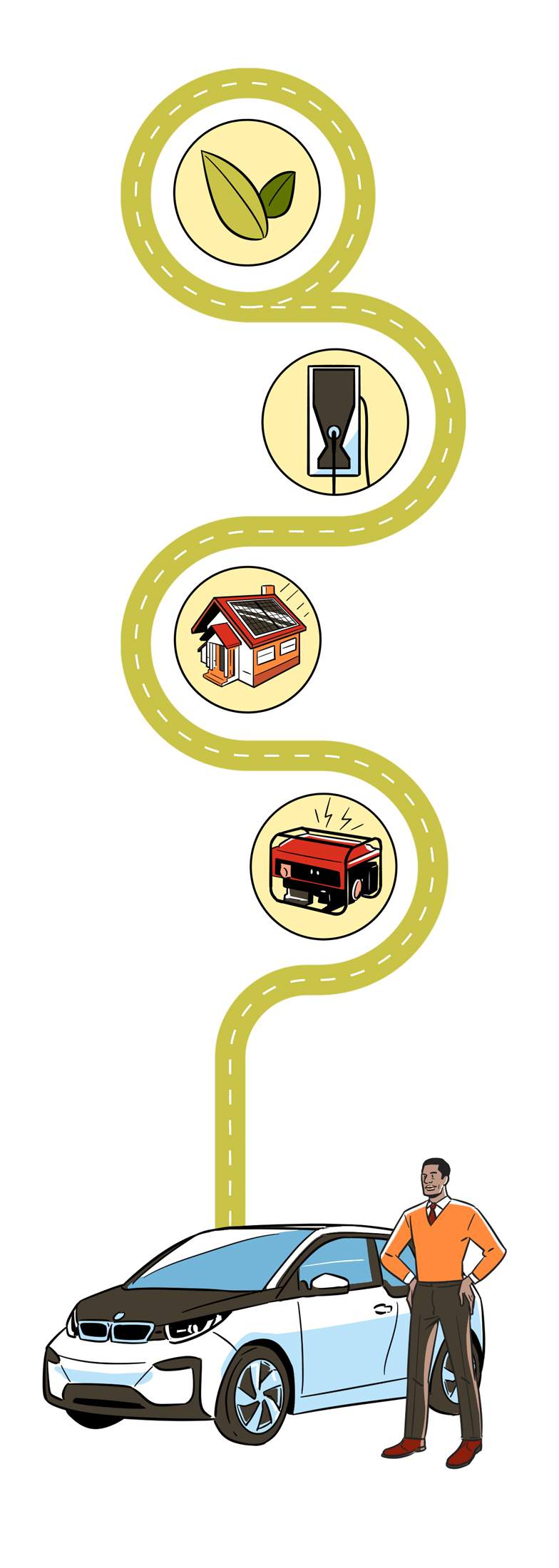
Power games
South Africa’s charging problem
The biggest challenge facing South Africa’s EV consumers is access to power (writes Mary Holland). Over the past 10 years, the country has struggled with electricity shortages that have caused blackouts for as many as eight hours a day, even in major cities such as Cape Town and Johannesburg. How many people would invest in an electric car in a country where there’s no reliable electricity to charge it?
The answer: not many. There are currently only about 1,000 EV owners in the country and David van Rensburg, who works in Cape Town’s IT and solar industries, is one of them. Along with a diesel car for long-distance journeys, Van Rensburg owns a bmw I3, a small, snub-nosed vehicle with a high roof. “I use it as a town runaround,” he tells monocle, adding that it can be driven for about 300km before needing to be recharged.
To cope with the outages, some EV owners have taken matters into their own hands by installing solar panels or buying generators, which perhaps defeats the object of owning an emissions-free vehicle. Those who still rely on public electricity have to factor in about 20 per cent more charging time in case of blackouts; in a worst-case scenario, they can recharge their cars at shopping malls that have their own generators, such as Cape Town’s v&a Waterfront.
The next hurdles are the lack of available brands and exorbitant prices. “EVs are too expensive because the import duties are very high,” says Van Rensburg (they are about 25 per cent, compared with 18 per cent for combustion-engine vehicles). As a result, there’s little sign of many major car-makers investing in the country. That seems like a big waste, given that South Africa has a booming automotive manufacturing industry that employs 900,000 people.
Meanwhile, there are only about 250 charging stations across the entire country and many of these are in garages in major cities. Cars with longer battery life, such as Teslas, aren’t yet available here, even though the car-maker’s co-founder and ceo, Elon Musk, hails from Pretoria. “If those types of cars came to South Africa, it would change the game,” says Van Rensburg, who, despite the high prices, limited offerings and spartan infrastructure, is always on the lookout for an upgrade. “My intention now is to buy bmw’s electric ix3 suv.”
Mary Holland is Monocle’s New York correspondent. She was born in South Africa.
In numbers: South Africa’s journey to a greener future
205 Number of days of electricity that South Africans lost in 2022 as a result of power cuts.
6 Number of electric vehicles per charging point in South Africa – the world’s fourth lowest.
75 per cent Proportion of the EV models available in South Africa that are from high-end brands, according to the International Energy Agency.
€7.8bn Finance package provided by developed countries to help South Africa shift from coal to clean energy.
The death of the petrol station
What LA will do when gas is illegal
“In LA, you can’t do anything unless you drive,” wrote Martin Amis in 1984. Even now, getting around here still means getting behind the wheel. As a result, petrol stations are crucial; there are more than 550 dotted around the city. But in September the state of California decreed that all cars and light trucks sold in the state will be zero-emission vehicles by 2035. With other states considering similar bills, the refuelling industry faces an adapt-or-die moment.
No one will miss the eerie haze that settles over Los Angeles on a windless day but the fate of California’s 5,081 “mom-and-pop” petrol stations remains foggy. According to one projection, about half will close as the state weans itself off gasoline. “But we won’t have a lot of abandoned gas stations,” says Paul Koretz, who served on the city council and tried to ban more being built. “A lot of housing could be built on top of these old stations.”
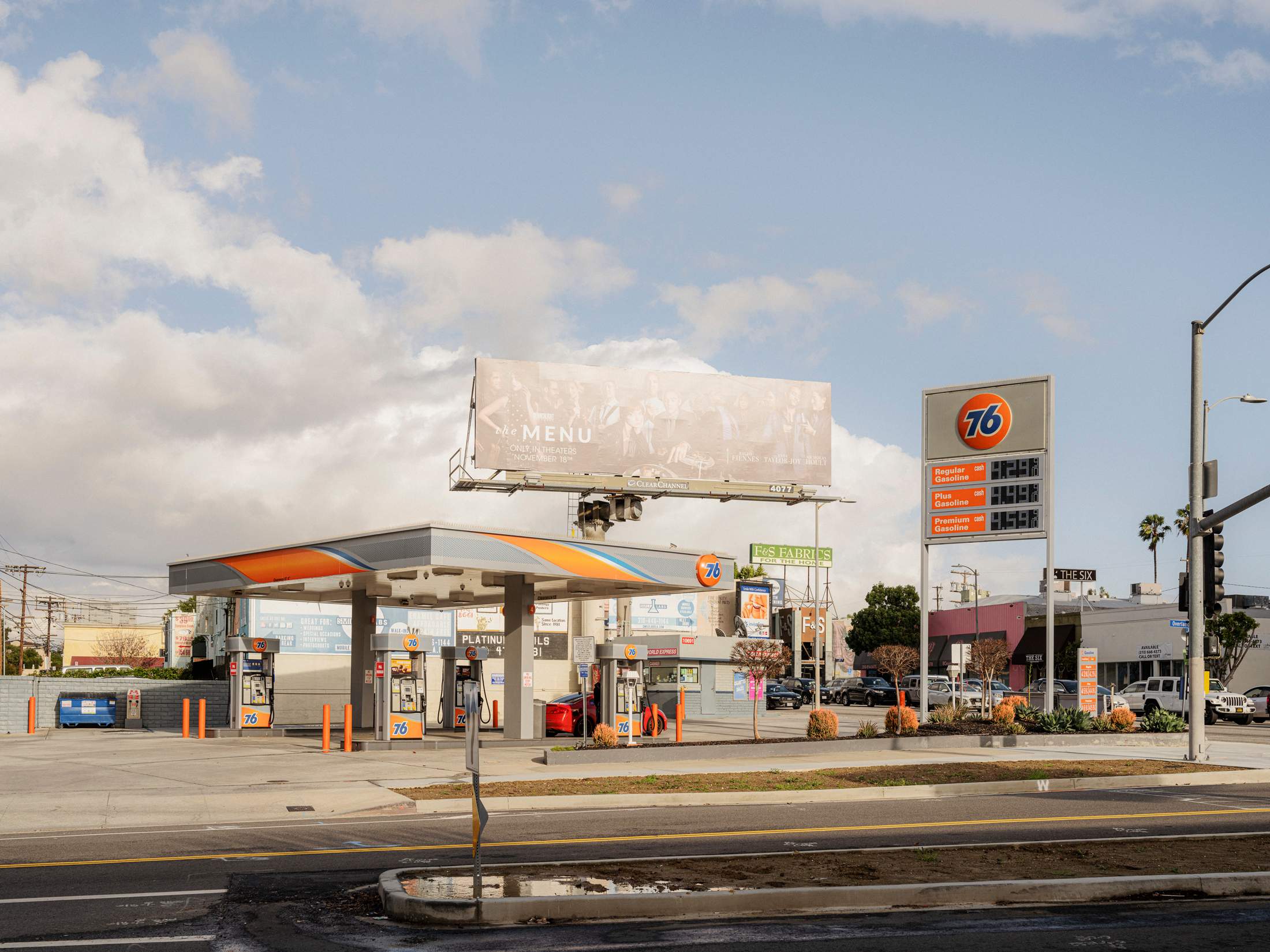
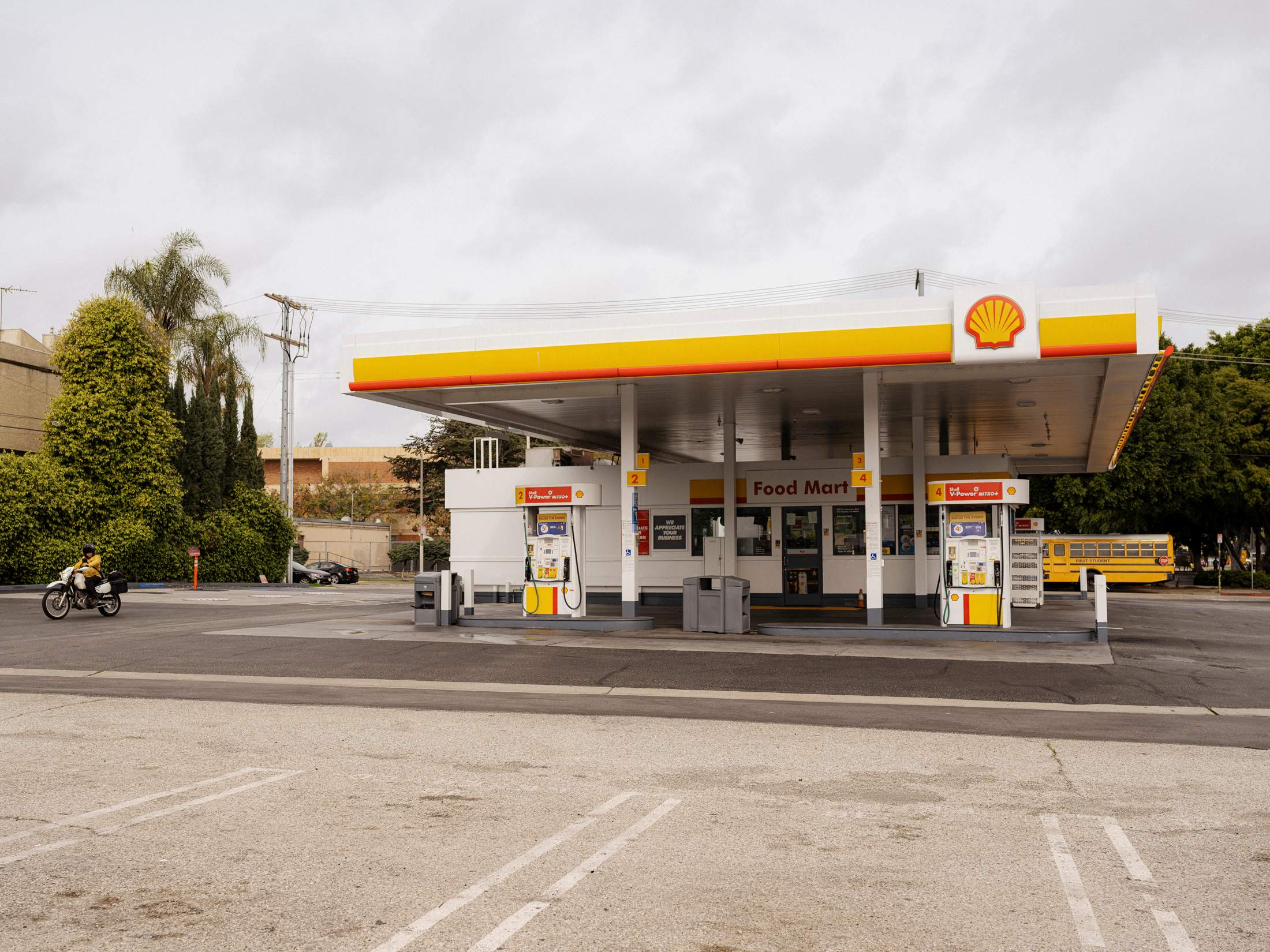
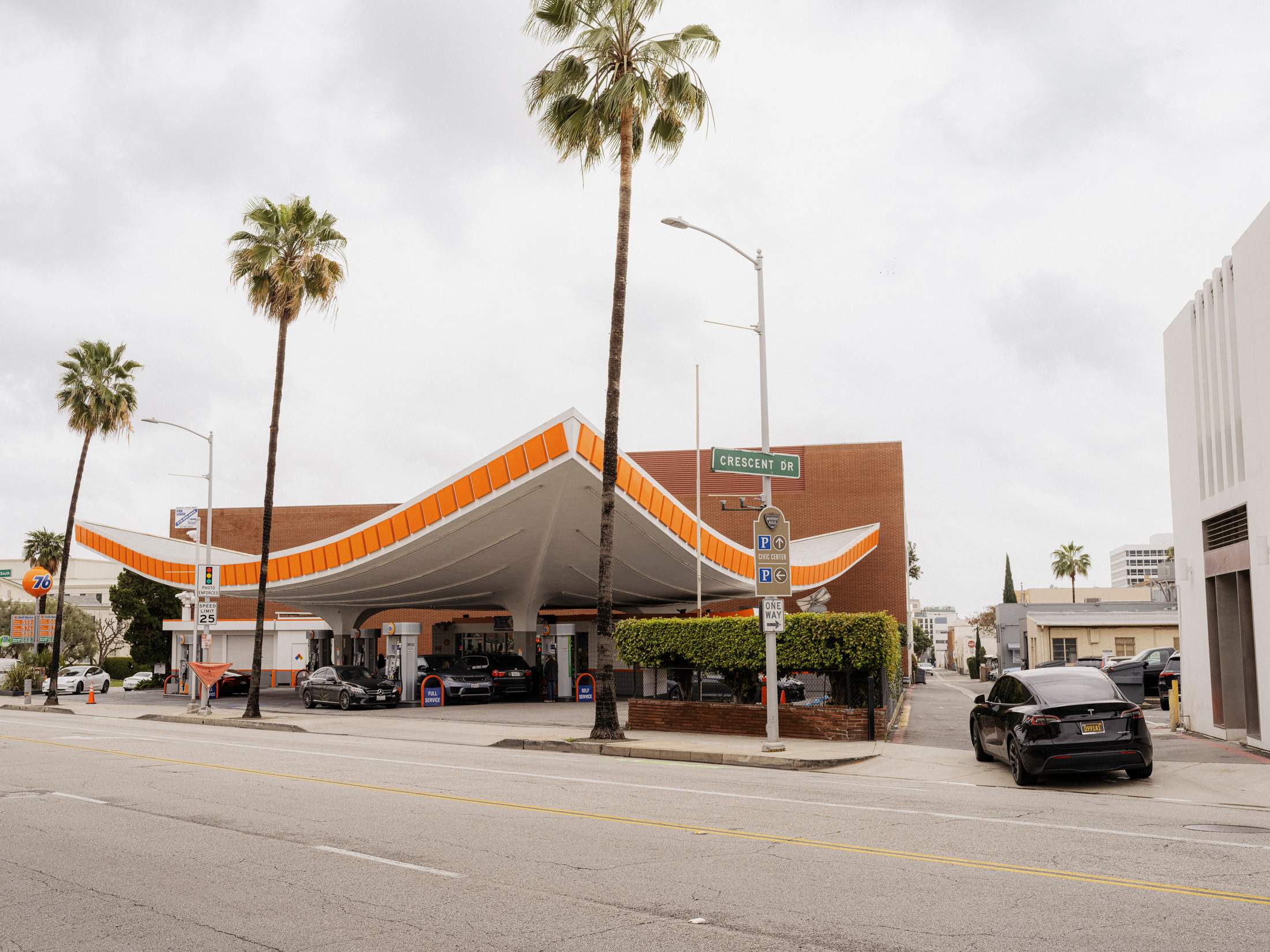
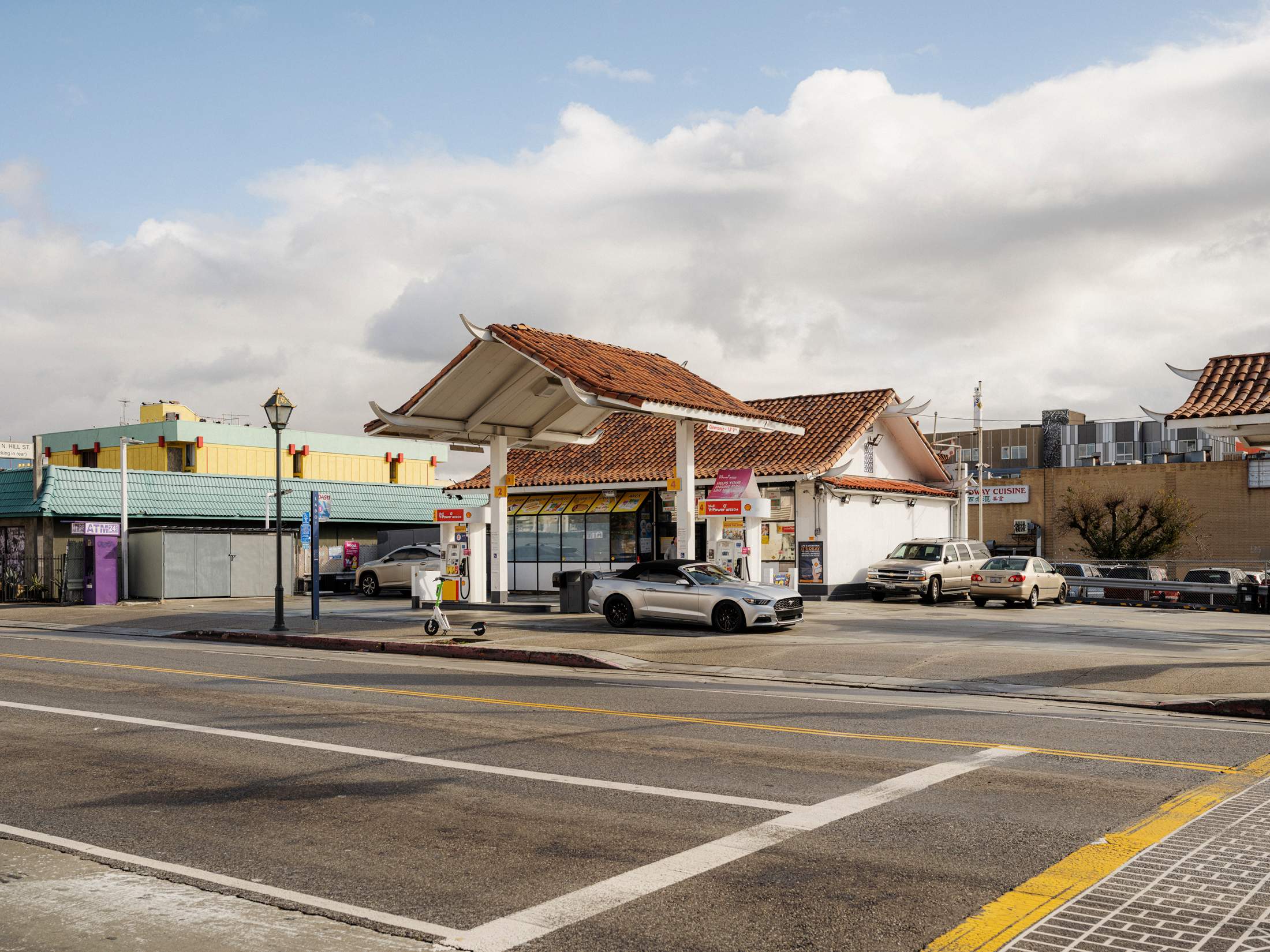


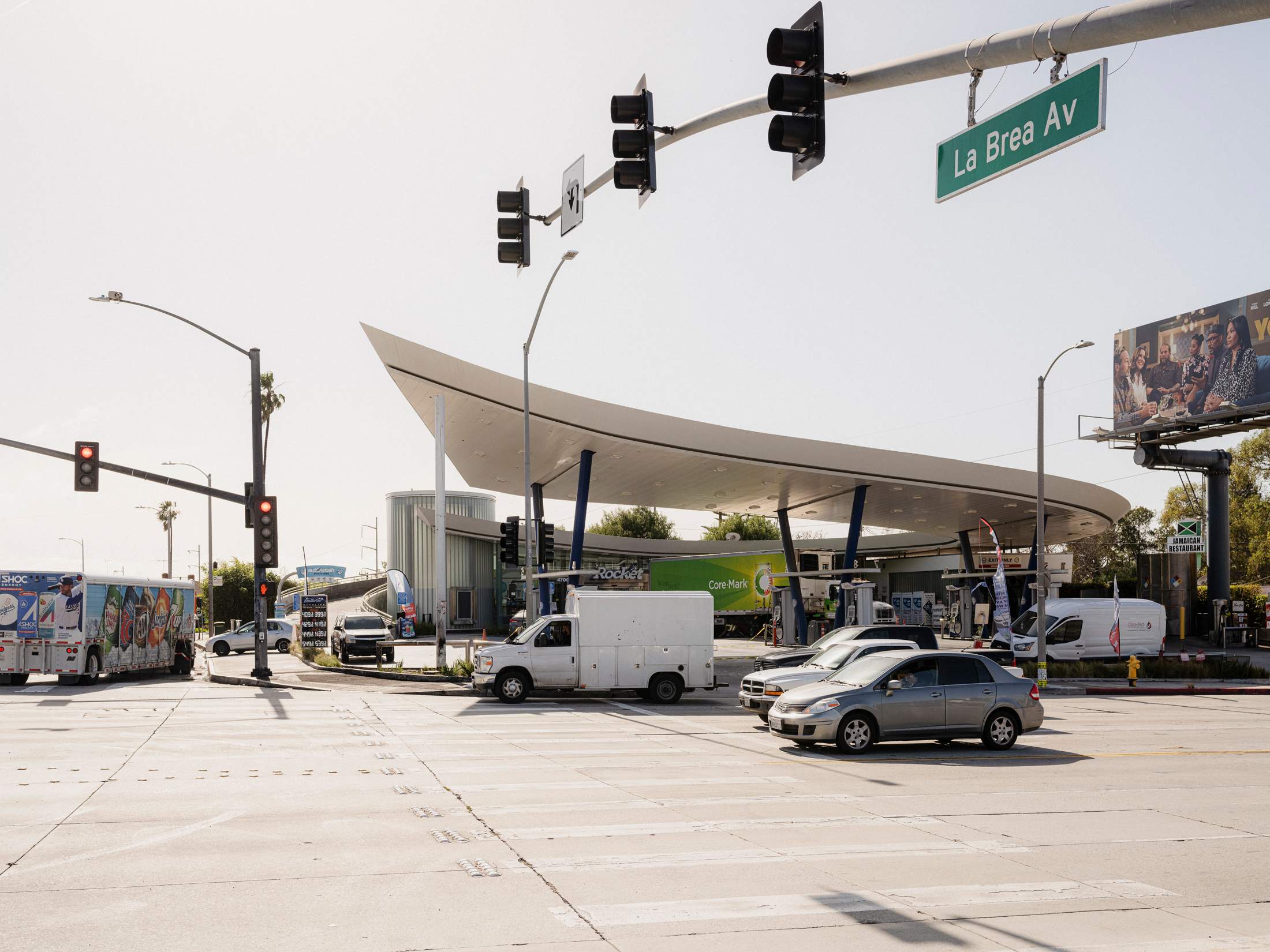
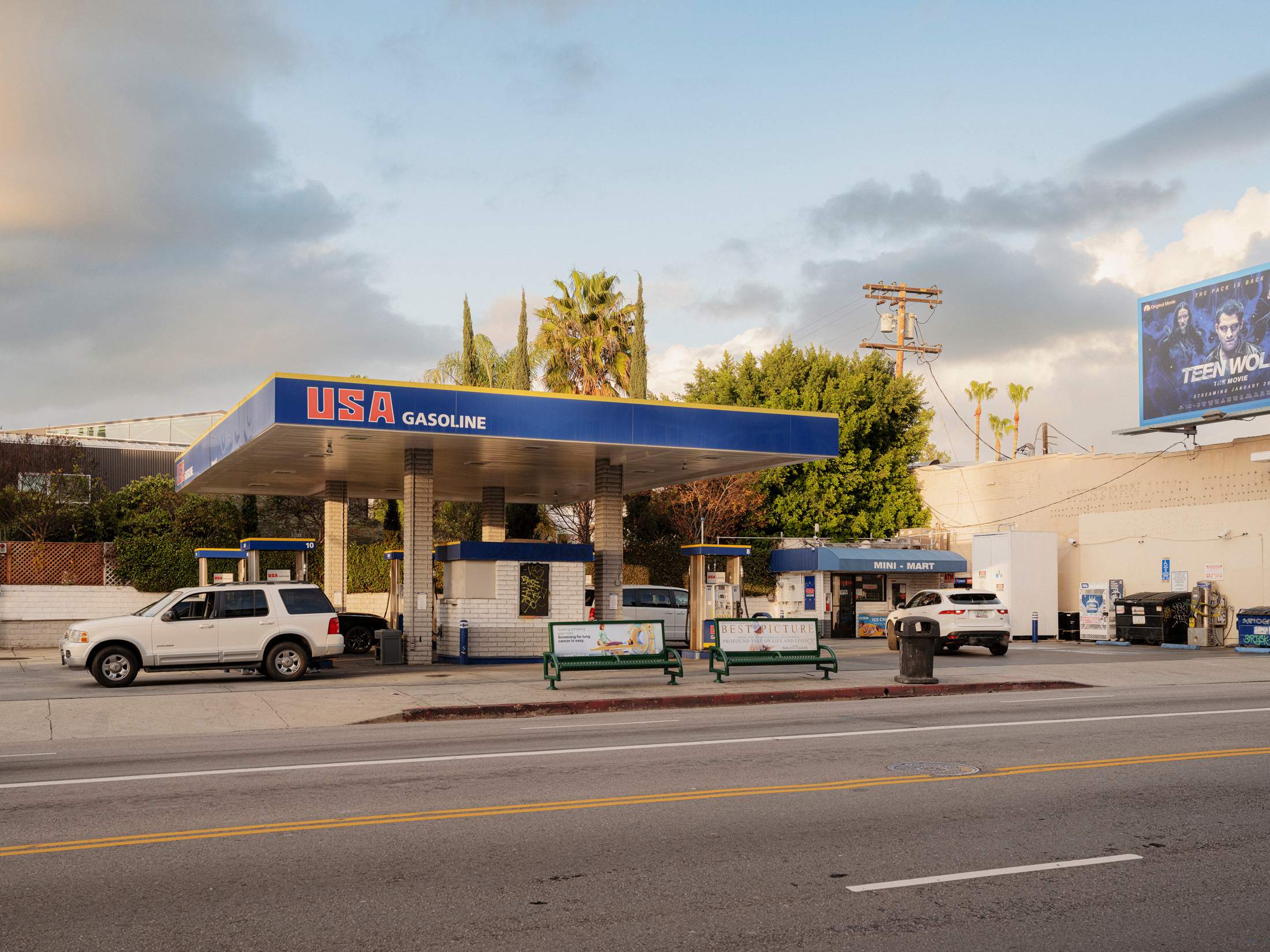
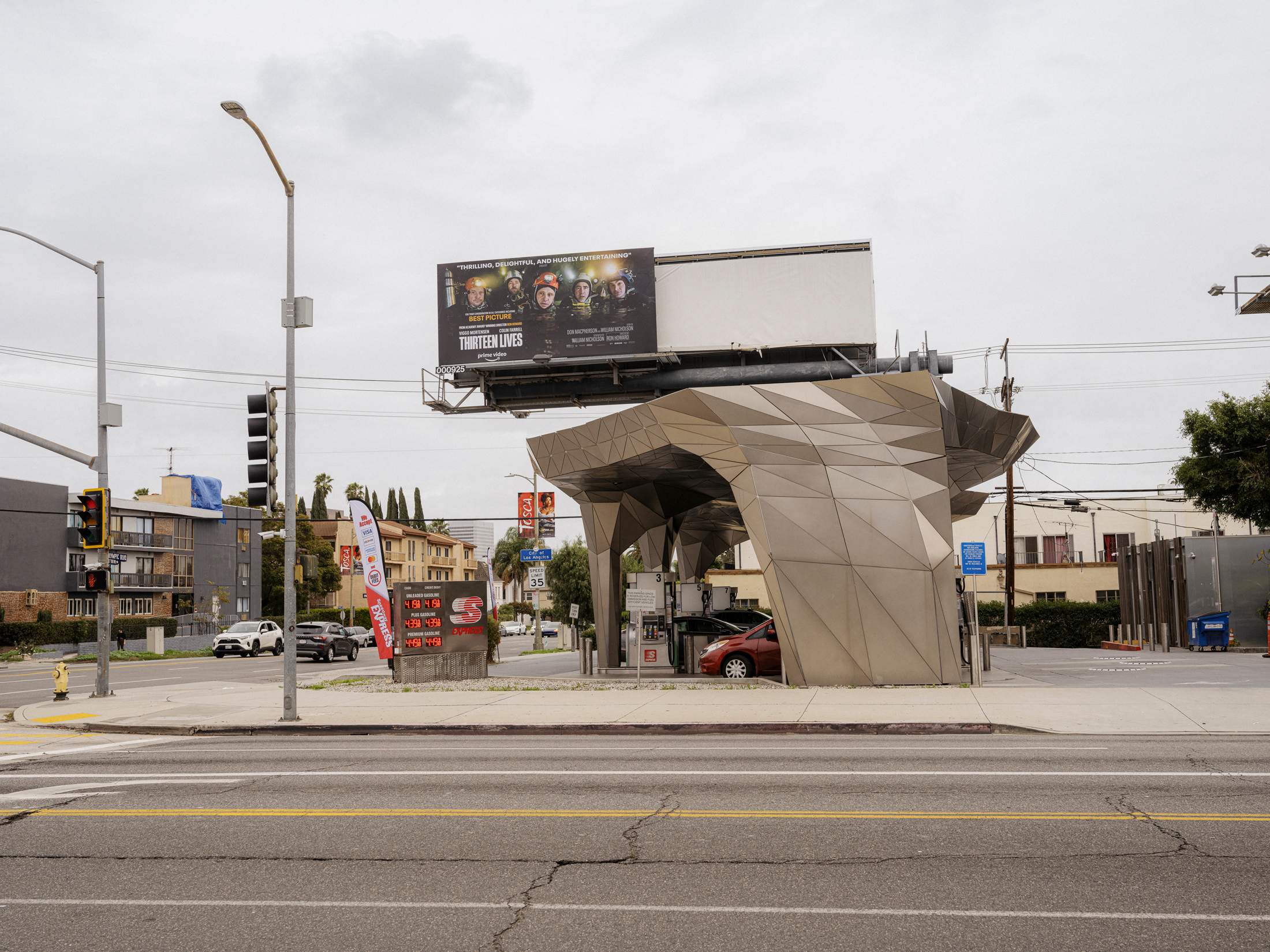
In 2020 the City of Los Angeles and the University of South California ran Pump to Plug, a symposium that invited urbanists to imagine the transition to electric. Australian firm Woods Bagot showed how obsolete gas stations could be redeveloped into new businesses, EV chargers, green space or much-needed affordable housing. But that would mean excavating underground petrol tanks and scrubbing brownfields of leakage, a project so expensive that it would only work if there were a coordinated clean-up at sites across the city. For the remaining stations, installing rapid chargers can cost up to €130,000, so federal assistance will be of existential importance.
But not everyone will be able to afford to switch to electric, says architect Jeffrey Inaba. “There’ll be less demand for gas [in some neighbourhoods] but it’ll still be necessary,” says Inaba, who presented “Station to Staytion” at Pump to Plug, reimagining petrol stations as community-driven rest stops that use the existing canopy for food trucks, business stalls and even movie screens. In LA, where the car is king, petrol stations are common spaces worth preserving. And if drivers switch to electric, they will spend a lot more time there, so improvements will be needed. The Full Service Coffee Co, housed in an art deco former petrol station built in 1941, offers some inspiration. The drive-in coffee shop opened in 2020. Here, instead of someone in a paper hat offering to fill your tank, a barista comes to your window to take your order. “I like the idea of these old places fuelling humans now instead of vehicles,” says co-founder Edoardo Chavarin.
California’s uptake of electric vehicles compared to the rest of the US
3.5 per cent Proportion of California’s 16 million cars that are currently electric.
39 per cent Proportion of EVs in the whole of the US that are found in California.
15,182 Number of EV charging stations in California.
29 per cent Proportion of the country’s charging stations that are found in California.
$174bn (€160bn) Money allocated by the Biden administration to help drivers transition to electric.
Look, no driver!
Japan’s autonomous buses move, hesitantly, ahead
Sakai in Ibaraki prefecture is the sort of town that you find all over Japan: small, semi-rural and home to a large population of seniors. In 2020, however, it became the first municipality in the country to have self-driving buses on its roads. They are painted in bright colours inspired by the area: blue for the Tone river and yellow for the rapeseed fields on the edge of town.
It’s easy to scoff at some of the pie-in-the-sky scenarios that proponents of autonomous vehicles have touted and their failure, so far, to deliver tangible benefits for the average citizen, in spite of considerable investment from governments, corporations and car companies. A future in which unmanned pods deliver goods and people all around our cities feels as distant as ever (give or take a few fast-food robot buggies). But here, automated driving is already a reality, rooted in the challenges facing Japan’s depleted countryside communities.

Brightly coloured driverless shuttle, part of a pilot in the town of Sakai
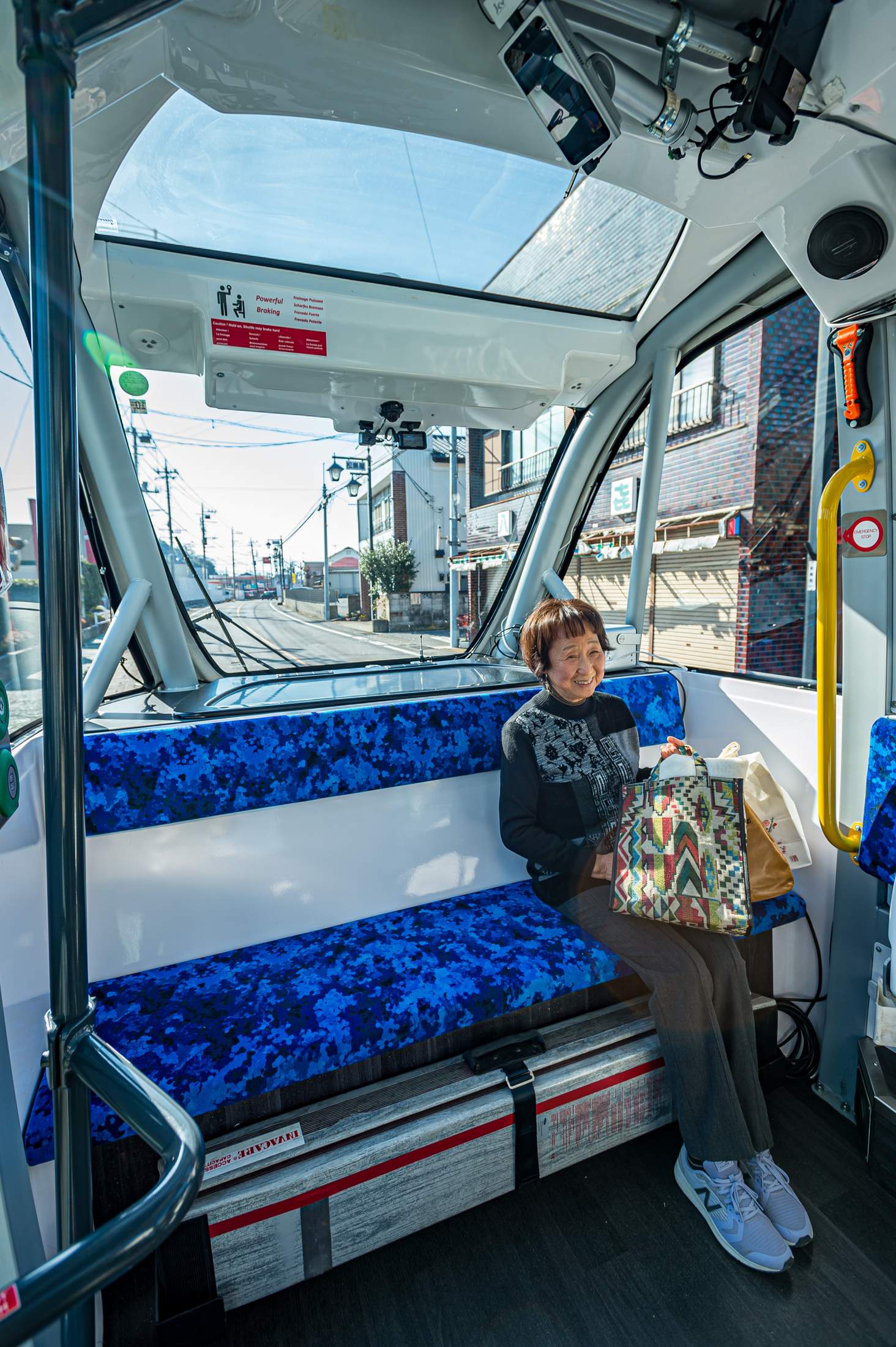
Spacious interior of the vehicle made by transport firm Boldly
Sakai’s automated-bus initiative is led by Yuki Saji, ceo of Boldly, a subsidiary of the Japanese technology conglomerate Softbank. Saji started the business when employees of the company were asked to come up with fresh ideas and he proposed a move into autonomous mobility, arguing that modern telecommunications and remote monitoring would make it all possible. Now he’s running the show.
“Autonomous vehicles make sense in Japan because there is a genuine demand,” he says. “Bus companies can’t get enough drivers in rural towns and passenger numbers don’t make services commercially viable.” Operated by people in the areas that they serve, these buses could be the answer. From April the government will allow people without car licenses to oversee driverless vehicles on public roads.
Saji takes charge of monocle’s vehicle with what resembles a video-game controller. The buses in Sakai, which move at a stately 20km/h, don’t strictly need a driver but there is always someone on board to assist passengers. Saji understands that people are wary of a vehicle with nobody behind the wheel. “I tell people to think of the buses as horizontal elevators,” he says. They are equipped with eight sensors that can detect obstacles up to 60 metres away but, according to Saji, the technology isn’t particularly complicated. “It’s like an iPhone 3,” he says.
Sakai’s population has been welcoming. Pensioner Mitsuko Sagara steps on and takes a seat. “I can still drive but it’s more relaxing on the bus,” she says. With the proportion of older drivers increasing in Japan, many new cars here come loaded with devices that stop drivers from nodding off, parking badly or forgetting to switch on their headlights. While confident drivers might not appreciate a robot taking the wheel, the technology is making the streets safer. “The rest of the world is ageing too, so what happens here could make a difference elsewhere,” says Saji.
Bundles of energy
The EV battery wars
Electric vehicles might be winning over more drivers but anyone waiting for a brave new world of personal mobility will likely be disappointed. In the short term, we appear to be set for more of the same, only slightly better. Whether politicians have the will to implement the necessary infrastructure to keep pace with the shift is another question.
The current lithium-ion battery technology is about as good as it can be. However, to leave fossil fuels behind completely, we need a longer-range, faster-charging alternative. That’s why almost every car-maker is working on figuring out the next step – and it’s the “solid-state” battery that holds the most promise.
These already exist in smaller consumer electronics but producing larger versions at scale is costly and difficult. But they are far less flammable than the current crop of batteries and replacing liquid electrolytes with solid ones will allow your power source to hold as many as 10 times more energy in the same mass and power up more quickly too. Japan is leading the way, with Toyota’s first solid-state-battery-powered EV slated for 2025 and Honda aiming to start a pilot line in 2024.
Then there’s the hydrogen fuel cell and its long history of false dawns. Hydrogen is far more energy-dense than the batteries used today and is exceptionally clean. Yet there is one big caveat. Its production, transportation, storage and delivery are riddled with potential problems. It is notoriously flammable and, at present, most of it is made using fossil fuels, so it isn’t all that green anyway. Hydrogen-fuel-cell cars are currently scarce and often more expensive than battery-powered ones; there’s also hardly anywhere to fill them up. Fewer than 4,000 were bought in Europe in 2021 and almost all of the 15,000 of them on US roads today are in California. Most are the Toyota Mirai, a pioneering model that was unveiled in 2014. Hyundai offers hydrogen cars too but overall sales figures are likely to remain tiny because building the infrastructure to offer convenient fill-ups would cost billions of dollars. It is unclear whether the benefits of hydrogen over battery power would outweigh those costs but a network of hydrogen truck stops is much more achievable.
EVs will gradually become more capable and more affordable, with charging networks growing more comprehensive over the coming decades. However, progress towards an emission-free global fleet of cars will be sclerotic in all but the wealthiest countries.
Brands beyond Tesla
The EV market has spawned several new brands. Here are some of monocle’s favourites.
Polestar: Publicly traded and counting Volvo Cars as a major shareholder, Polestar makes sleek vehicles and stays competitive with an asset-light business model: it has more than 2,000 staff.
Lucid Motors: This Silicon Valley manufacturer has built premium EVs since 2016. Its Lucid Air model can go 185km further than any Tesla.
Rivian: Supported by Ford’s automotive knowhow and Amazon’s investment, Rivian is developing a network of public charging stations across the US and Canada.

Tanner Krause
Q&A
Tanner Krause
ceo of kum & go
Corner-shop empire Kum & Go, headquartered in Des Moines, Iowa, is expanding across the US and plans to double its network of 400 shops over the next decade – and every new outpost will sell fuel. monocle spoke to Tanner Krause, Kum & Go’s ceo, to find out more.
Why are you opening new petrol stations?
Our long-term goal is to end our dependence on fuel but the adoption of electric vehicles [EVs] is far slower in middle America than on the coast. Wyoming, for instance, recently tried to ban the sale of EVs by 2035 to support its oil and gas base – and we do business in more states that govern like Wyoming. But in larger metropolitan areas, such as Denver or Detroit, we’re trying to be more of a high-quality neighbourhood food market with less emphasis on fuel.
Are electric chargers important for Kum & Go?
By the end of the year, more than 10 per cent of our locations will have charging stations. You’ll be hard pressed to find an operator with that kind of penetration. We don’t expect charging revenues to fully replace liquid-fuel margins; I doubt that there’s anyone in our industry who could survive without fuel right now because it also brings indirect business, such as when people come in to buy a cup of coffee.
EV uptake is quite low in much of the US. How much of a hurdle is that?
It’s poor policymaking to assume that all of America is moving at the same speed. You have to be careful to avoid blanket mandates. California has always led the way when it comes to environmental consciousness and I applaud it for that but there’s a lot of difference between how people act in the Bay Area and how they behave in California’s Central Valley, for instance. Good intentions shouldn’t get ahead of good policy.
Stay behind the wheel
Why I won’t let AI in the driver’s seat
Electric cars? Sure (writes Robert Bound). You need to burn something somewhere to keep the wheels turning – but that chimney and that power station won’t be on your high street, choking God’s Chosen Race of Two-Wheeled Bell Ringers, or next to your child’s school, or anywhere that really matters because they’ll probably be in a far-off Lincolnshire field or a desert in Arizona. But driverless cars? No, thanks.

It is true that one of Uber’s driverless test vehicles has already killed, with tragic irony, perhaps the only cyclist in the state of Arizona. Historians with an appetite for Luddite schadenfreude have linked that death to the demise in 1830 of former UK cabinet minister and railway devotee William Huskisson, who was run over by the very locomotive that he was championing as speedy and safe. He was slain by the monster that he had set free, like a sad Dr Frankenstein with a meddling interest in 19th-century northern-English infrastructure. As the onboard announcement might have monotoned on that terrible day, “Welcome to this inaugural service from Liverpool to Manchester via Huskisson.”
But it’s not that fateful historical echo that should put off the sane mind. It’s my conviction that, to put it simply, driverless cars will be driven – or not driven – by dicks. Yes, those “tech bros” who believe that Tesla’s co-founder and ceo, Elon Musk, is a witty maverick for releasing vehicles with a power-boosting setting called “Ludicrous”, a cringeworthy “Celebration” mode and a satnav that pretends that you’re on Mars.
I strongly suspect that these are the sort of people who might magnanimously suggest to their wife that they will “share the driving” on the night of a party, which inevitably turns out to mean that they’ll drive to the venue so that they can get drunk when they’re there and be driven back. I bet that many of them are also the kind of toady forelock-tuggers who, like an embarrassed dog, lick up every last drop of Silicon Valley’s retched-up Kool-Aid from their own driveway and only wish that it came in more flavours.
So, there’s that. I do understand that driving in Los Angeles, for example, is to always be on the verge of flipping out like Michael Douglas’s character in Falling Down but traffic jams are one of the Holy Sacraments of living in the City of Angels. And, yes, maybe you could use all of that passenger time by maxing out your Duolingo account to learn Korean and Magyar so that you can finally converse with your favourite Onlyfans performers – but they still won’t give you a discount, you filthy animal.
For me, the central thing is that the designers and champions of driverless cars don’t seem to realise that people actually like driving. Many of us enjoy being in control of a vehicle that can whisk us far beyond our immediate horizon. Being behind the wheel on an open road has always been exciting in a way that riding a bus could never be.
There is something quintessentially Silicon Valley and definitively solipsistic about the men who want to inflict driverless cars on the world and their seeming belief that humanity wants no responsibility, no self-determination and no control; that it wants to live in a consequence-free capsule and to reach a state of sublime future-banality. It especially wants a satnav that – ha, ha, brilliant! – pretends that you’re on Mars. Tesla and co? They can beat me off at the lights.
Robert Bound is Monocle’s senior correspondent.
Plugging away
The charging station of the future
With rapid charging times for electric vehicles (EVs) currently at between 20 and 40 minutes, designers around the world are turning their attention to the future of the charging station, especially those that cater to drivers on long-distance routes (writes Nic Monisse). Many of the proposals attempt to create a new building typology that ambitiously combines electric chargers with facilities such as gyms, playgrounds, galleries, hot-desk-style workspaces and food outlets.
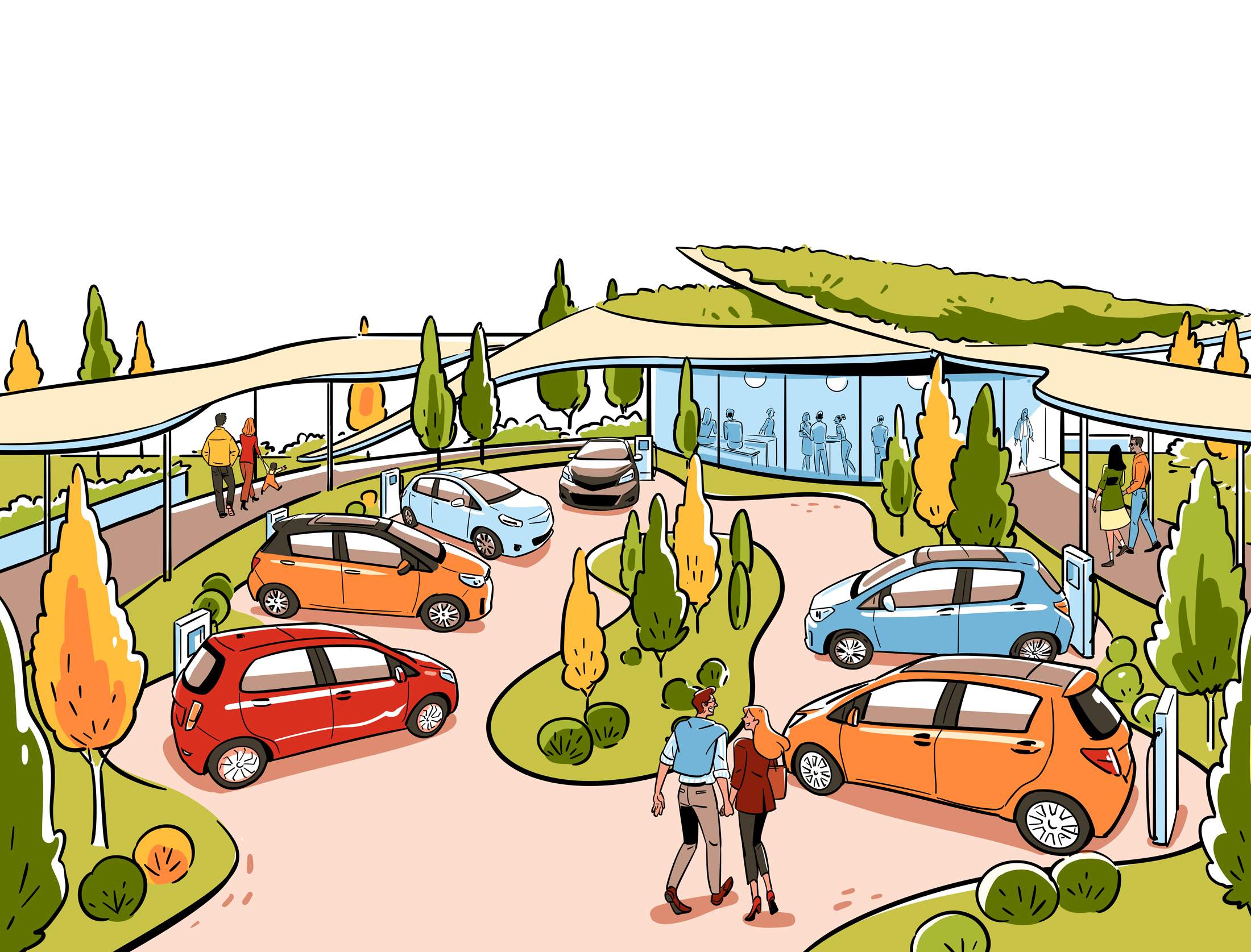
Few of these designs, however, seem to have taken into consideration whether such activities will actually be enticing for someone who is on an hours-long cross-country drive. I would argue that they won’t be. Add to this the reality that battery technology is quickly progressing – according to scientists at Penn State University, batteries that can recharge to 70 per cent in about 10 minutes have already been developed – and the idea of building a dedicated facility in response to today’s charging times begins to seem short-sighted.
Meanwhile, car-makers such as Audi are planning a new wave of pod-style vehicles that look more like moving living rooms than conventional automobiles, so owners of the future might be reluctant to leave their cosy confines for a sweaty roadside gym. (They will also need to be lugging around a change of clothes and toiletries for that.) With all of that in mind, there seems to be little reason to start from scratch.
The fixes that we need are far simpler: for example, a small café and shop without fluorescent lighting or a counter serving dry sausage rolls. Or how about consistently clean bathrooms? An inviting garden where road-weary drivers can refresh themselves by enjoying a short walk would be a bonus too. It’s important to remember that electric-charging stations on highways and country roads – like ordinary petrol stations – will be places to drive through, not places to drive to.
Nic Monisse is Monocle’s design editor.
Race to the top
EV vs ICE
Despite the global surge in enthusiasm for EVs, most vehicles on the road are still powered by an internal combustion engine (ice). The industry is entering a phase of meaningful transition. This is reflected in the decisions facing drivers; many motorists who own an ice vehicle intend to buy an EV as their next car. Here, things get complicated. It takes an enormous amount of energy to make a new car and, according to one school of thought, it’s more environmentally friendly to keep an old ice vehicle on the road for as long as possible than to trade it in for a new EV. Is that true? To assess this, you have to account for the entire life cycle of a vehicle. This can be broken into its manufacture, its operation on the road and its disposal. Shall we take a spin?

Manufacture
At the manufacturing stage, EVs can generate about 80 per cent more emissions than a comparably sized ice vehicle. Most of the pollution is generated making lithium-ion batteries, their most common source of power. This requires the extraction of minerals including lithium, cobalt and nickel from the ground, before heating them to high temperatures. The process uses a huge amount of (usually non-renewable) energy. Many of these minerals are extracted by workers in poor countries under hazardous conditions.
Operation
Once an EV has left the forecourt, however, it rapidly begins closing the emissions gap with ice cars. Research by The Wall Street Journal and the University of Toronto compared the emissions of two of the most popular cars on the US market, the Tesla Model 3 (EV) and the Toyota rav4 (ice). For every mile driven, powering the Tesla with electricity emits 34 per cent of the emissions associated with powering the rav4 engine with gasoline. By 20,600 miles (33,152km), the greenhouse gas emissions from building and driving the two cars level out. For every mile past this, the lifetime emissions of the Tesla are lower. Exactly how much less a new EV will emit over a given period compared to an old ice car depends on the power supply. Simply put, the cleaner the energy grid in an area, the lower the carbon cost of charging an EV.
Disposal
At the end of its life, an EV’s battery again becomes a liability. Only about 5 per cent of lithium-ion batteries are currently recycled in the US and the chemicals they contain can be highly polluting if they leak out of landfills. But more and more companies are cropping up that specialise in responsible disposal.
Conclusion
The big takeaway from looking into the new-EV versus old-ice question is how contingent it is. Location is a big concern. You can avoid the ethical concerns around lithium batteries by buying a hydrogen-powered fuel-cell electric vehicle (fcel). But that won’t make sense unless you live in Japan, the only country with a workable number of hydrogen filling stations for its size. On the other end of the spectrum, West Virginia’s grid is so dirty that a hybrid vehicle has an emissions advantage over a pure EV because of the amount of coal that must be burned to charge a battery.
Our technical capabilities – such as our capacity to harness lithium sustainably – will continue to improve, even as protectionist manufacturing policies might complicate the EV supply chain. As much as we would like clear-cut answers to questions of sustainability in motoring, the wisest stance over the next few decades will be a combination of stoicism, flexibility and attentiveness to the conditions of specific markets.
At face value
For an increasing number of motorists around the world, the environmental footprint of a vehicle is a key consideration when purchasing a new car. The first hurdle for many, however, is the cost of an EV in comparison to those of combustion-engine vehicles.
Average prices, according to Kelley Blue Book (2022)
$56,656 (€52,324): Average price of a new ice vehicle.
$64,454 (€59,520): Average price of a new EV.
$30,913 (€28,547): Average price of a used ice vehicle.
$52,413 (€48,401): Average price of a used EV.
photographer: Ramon Haindl, Matthew Scott. images: Getty Images, illustrator: Peter Zhao

